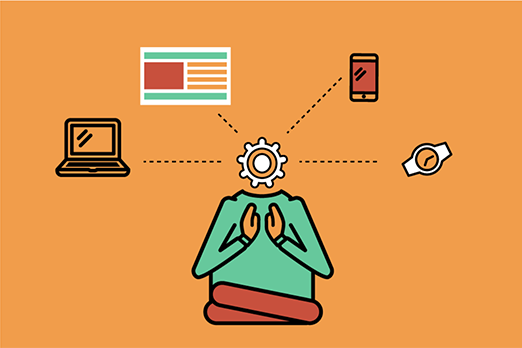5 Reasons Adopting an API-First CMS is Critical for Your Business

Do you think using a single tool to boost developer productivity and longevity, future-proof your content, delight users, deliver consistent marketing, and get all of these hard-earned efforts to market well before your competitors sounds too good to be true?
If so, then you’re probably making the same mistake that far too many enterprise-level businesses are—entrusting your content management to a popular, traditional CMS tool.
In this piece, we’re going to explore today’s leading CMS technology, list several reasons why it’s critical to the future of your business, and show how a game-changing CMS pioneer like Contentstack makes it easy to adopt and adapt to business today.
What is an API-First CMS?
An API-first CMS, also often commonly called a headless CMS, integrates content management tools via Application Programming Interface (API). By truly separating content from how it’s eventually going to be displayed, a headless CMS ensures content is ready to publish to any device or channel at any time.
With an API-first approach, content becomes a highly-accessible service that can be called by a website, a mobile device, a software platform, an automobile, VR headset, voice-activated devices, Jumbotron or whatever tomorrow’s technology looks like.
Headless is the latest evolution in the long and storied history of content management systems. To best understand its impact, let’s take to look at what sets it apart from other content management solutions on the market.
What Sets an API-First CMS Apart from Traditional and Decoupled CMS Solutions?
When using what’s come to be known as a “traditional CMS” like WordPress or Drupal, end-users such as marketers create and edit content with WYSIWYG or HTML editors. Content is saved to a built-in database and displayed according to whatever front-end delivery has already been built in. The content and its formatting are coupled—which will matter more in a minute.
Imagine in this scenario that the content is the "body" and the front-end display (elements users will see such as formatting, navigation, layout, etc.) is the “head.” By removing those front-end elements, you will effectively remove that head to create a headless CMS.
A headless, API-first CMS has no built-in front-end system that determines how the content will eventually look to end users. Instead, front-end developers have the freedom to build whatever kind of interface they want and use an API to simply call up the content. This makes it easy to compete in an omnichannel world where marketers need to serve consistent content everywhere from websites to apps, kiosks, chatbots, smartwatches, connected home devices, voice assistants, and much more.
A headless CMS is basically a more flexible and freeing type of decoupled CMS. It has all the options of a traditional CMS without being locked into a specific language or user interface.
There’s no doubt that AI, machine learning, and other new technology will continue to disrupt the field of content management. That’s why, at
Contentstack, we pioneered the concept of API-first CMS technology so our customers can keep delivering the best digital experiences and omnichannel marketing that’s secure, scalable, and future-proof.
Here are five reasons we believe an API-first, headless CMS is critical for businesses trying to compete in today’s a digitally-transformed environment.
5 Reasons Adopting an API-First CMS is Critical for Business
1. Increases Developer Productivity and Longevity
Traditional content management systems gained popularity during a time when diverse development languages were rare and an all-in-one solution looked awesome next to the complicated, DIY solutions on the market. However, today that all-in-one solution is like a set of handcuffs holding businesses back from optimizing their content on a variety of marketing and sales channels and internet-enabled devices.
A traditional CMS limits you to a single development platform. Aside from only being able to take advantage of a sliver of the ever-growing technology universe, this also limits you to having to find and hire a very specific type of developer.
Preferably, they’re very well-versed in one specific language. Even more preferably, they already know the ins and outs of your particular CMS. And most preferably—and concerningly—they’re totally complacent with continuing to use that CMS so as not to interrupt the business processes you’ve built around it.
What’s a company to do if they can’t find several of these unicorns in the wild? Spend the time and resources recruiting and training them to fit a very specific niche that hopefully doesn’t get outdated anytime soon.
Save time and resources and build a development team that loves their jobs by replacing your traditional CMS with an API-first CMS.
source
An API-first CMS empowers your development team to use what they know, what they love, and what they think will be a perfect solution in every unique situation. Increasing productivity isn’t the only thing that will save you time and money in this case—just consider the longevity of developers who have a variety of skills and actually want to put them to work for you.
When your hiring decisions are less dependent on a traditional CMS, you’ll find that your development team has a deep skill set that can be applied to a variety of projects. This gives them the chance to learn new tech, exercise their creative muscles, and enjoy the job that keeps them with your company for years to come.
2. Future-Proofs Your Business (and Content)
It’s human nature to want to plan a project based on a static, “finished” state we have laid out in our heads. I mean, who among us hasn’t fallen into the trap of giving something an implementation-specific name like “Christmas 2018 slider” or “top-right sidebar” in our wireframes or content models?
However, it’s the nature of technology to continuously evolve beyond even our best-laid plans. To reconcile the two, it’s critical that businesses adopt an API-first headless CMS.
A headless CMS allows businesses to separate the process of creating content from the process of planning how content is going to be displayed to end users. This allows us to create content modules that are fluid enough to evolve separately from each other and stand the test of time as your website inevitably needs updating; the variety of display channels continues to grow; and the use of mobile devices like watches, glasses, and smartphones overcomes that of desktop machines.
In addition, when content isn’t anchored to a specific CMS platform, you’ll be able to switch out the technology upon which it’s hosted as needed—further future-proofing your hard-earned content by using the most suitable frontend to garner engagement.
3. Empowers a Delightful User Experience
Because it empowers them to use the best technology for the situation, an API-first CMS allows front-end developers to build delightful user interfaces that are simply not possible when using traditional, server-side CMS tech—all without limiting functionality or autonomy for content folks on the backend.
These interactions add a ton of personality and character to your brand’s online presence, which is becoming critical as businesses strive to differentiate themselves on something other than branding, selection, or price in a world of increasingly-connected and competitive digital marketplaces.
4. Makes Marketing Consistent in an Omnichannel Environment
The age of omnichannel is upon us. For marketers, this means developing an approach that gives customers (and leads) an integrated, seamless experience whether they’re interacting with your brand from a desktop or mobile device, in a brick-and-mortar store, via a marketplace such as Amazon, or anywhere else on any kind of device.
The majority of shoppers have been shown to shop in in multiple physical and digital locations. And the more active they are in more locations, the more likely they are to spend more, be more loyal, and refer more people to your business. It’s clear that omnichannel marketing is critical for remaining competitive business—and an API-first CMS is the best way to tackle it.
API-first headless CMS platforms are built to distribute content directly to a variety of channels and devices using the most optimal technology for each endpoint. They’re among the first and the most powerful technologies that cater to the omnichannel future of business.
Without such an effective CMS, marketing consistency is one of the first things to suffer. And while it seems minor, even small inconsistencies in messaging and design from platform to platform can shatter the trustworthy, savvy, and expert image you want to present to users. When your competitors are simply a click away—consistent omnichannel marketing might be the only thing keeping consumers and leads engaged with your business.
5. Improves Agility to Get You to Market Faster
An API-first CMS provides a simplified, streamlined experience for IT, marketing, and other business-critical units who need to deliver value to your market in record time.
When it comes to implementing and deploying updates to your content management system, no CMS is as fast or as simple as an API-first one. That’s because the CMS itself is separate from any custom code, so continuous deployment and other agile development techniques can be used to update and rollback changes quickly without scheduled downtime or the risk of breaking your entire content management platform.
And because your API-first CMS allows developers to create a platform of complementary technologies that they know and use every day, they have more control and fewer surprises. This means predictable, easy-to-launch projects instead of a team of developers wasting precious time figuring out antiquated technologies or building in workarounds for a pre-established, traditional CMS.
Will Your Business Adopt an API-First CMS or Will It Perish?
Headless, API-first CMS architecture isn’t for everyone. If your business wants to keep training developers to deploy content to a static, over-built CMS and ignoring the trend toward omnichannel marketing and sales—then, by all means, stick with a traditional CMS.
But if you want to remain relevant in a digitally-transformed business environment, an API-first CMS is critical.
When you adopt a CMS like
Contentstack that’s easy to build and even easier to customize, you’ll be well on your way to boosting developer productivity and longevity, future-proofing your content, delighting users, delivering consistent marketing, and getting all of these hard-earned efforts to market well before your competitors.
And if you need all of these benefits without shelling out to rebuild your entire IT department,
consider Contentstack’s enterprise-level headless CMS. Our promise is to deliver amazing experiences with reliability, scalability, and no-training-required content management tools.
Try us today for free. We stand behind our reliability and your ROI 100 percent.
About Contentstack
The Contentstack team comprises highly skilled professionals specializing in product marketing, customer acquisition and retention, and digital marketing strategy. With extensive experience holding senior positions at renowned technology companies across Fortune 500, mid-size, and start-up sectors, our team offers impactful solutions based on diverse backgrounds and extensive industry knowledge.
Contentstack is on a mission to deliver the world’s best digital experiences through a fusion of cutting-edge content management, customer data, personalization, and AI technology. Iconic brands, such as AirFrance KLM, ASICS, Burberry, Mattel, Mitsubishi, and Walmart, depend on the platform to rise above the noise in today's crowded digital markets and gain their competitive edge.
In January 2025, Contentstack proudly secured its first-ever position as a Visionary in the 2025 Gartner® Magic Quadrant™ for Digital Experience Platforms (DXP). Further solidifying its prominent standing, Contentstack was recognized as a Leader in the Forrester Research, Inc. March 2025 report, “The Forrester Wave™: Content Management Systems (CMS), Q1 2025.” Contentstack was the only pure headless provider named as a Leader in the report, which evaluated 13 top CMS providers on 19 criteria for current offering and strategy.
Follow Contentstack on LinkedIn.






.svg?format=pjpg&auto=webp)
.svg?format=pjpg&auto=webp)
.png?format=pjpg&auto=webp)






.png?format=pjpg&auto=webp)








